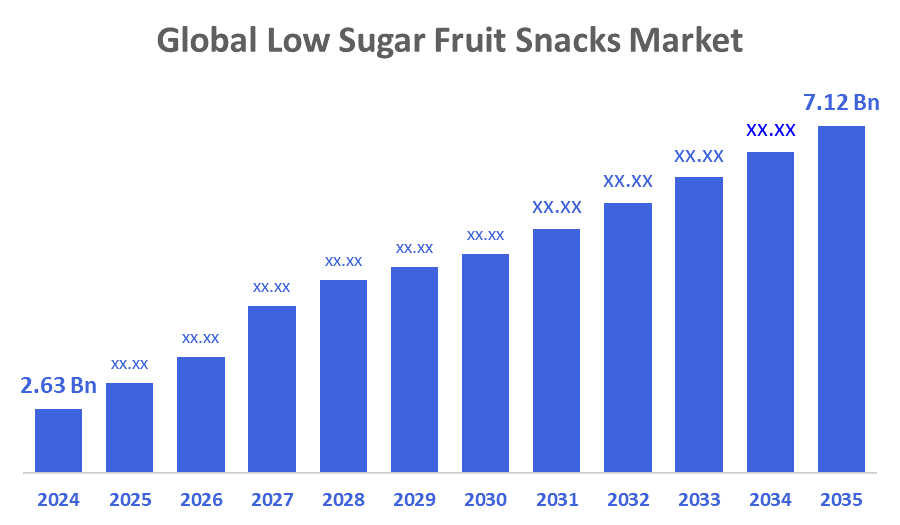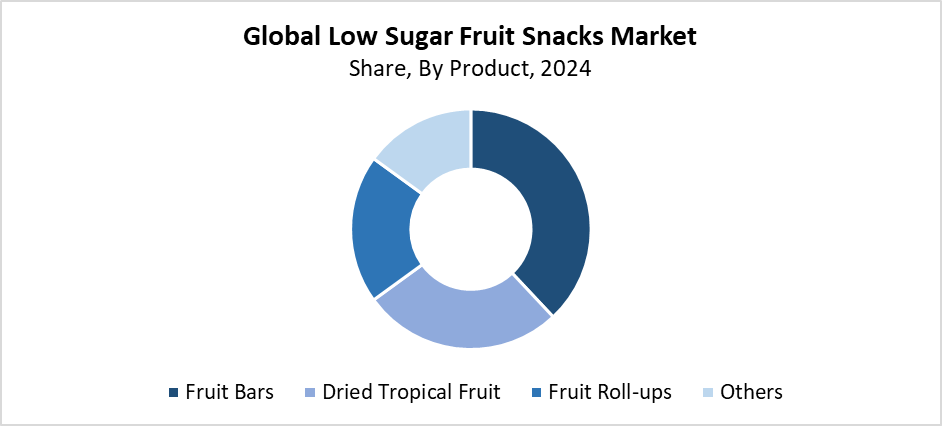Global Low Sugar Fruit Snacks Market
Global Low Sugar Fruit Snacks Market Size, Share, and COVID-19 Impact Analysis, By Product (Fruit Bars, Dried Tropical Fruit, Fruit Roll-ups, Others), By Distribution Channel (Hypermarkets & Supermarkets, Online Retailers, Convenience Stores, Others), and By Region (North America, Europe, Asia-Pacific, Latin America, Middle East, and Africa), Analysis and Forecast 2025 - 2035
Report Overview
Table of Contents
Low Sugar Fruit Snacks Market Size Summary
The Global Low Sugar Fruit Snacks Market Size Was Estimated at USD 2.63 Billion in 2024 and is Projected to Reach USD 7.12 Billion by 2035, Growing at a CAGR of 9.48% from 2025 to 2035. Growing health consciousness, a desire for low-calorie and diabetic-friendly foods, clean-label preferences, and an increasing awareness of natural ingredients, particularly among consumers looking for healthier snack options for both adults and children, are the main factors propelling the market for low-sugar fruit snacks.

Key Regional and Segment-Wise Insights
- In 2024, the North American market for low-sugar fruit snacks generated the largest revenue share of 31.5% and led the market worldwide.
- With the largest revenue share of 38.4% in 2024, the fruit bars segment led the market based on product.
- The supermarkets and hypermarkets segment had the biggest revenue share in 2024 and led the market by distribution channels.
Global Market Forecast and Revenue Outlook
- 2024 Market Size: USD 2.63 Billion
- 2035 Projected Market Size: USD 7.12 Billion
- CAGR (2025-2035): 9.48%
- North America: Largest market in 2024
The low-sugar fruit snacks market includes products made from fruit with reduced sugar content to meet the needs of people who want healthier snack choices with fewer calories. The market offers natural sweet snacks that include fruit bars, dried fruits, fruit leathers, and gummy snacks which contain minimal added sugar. The market expansion occurs because people want natural products with clean labels. Obesity and diabetes rates increase and they want to stay healthy. The market expansion occurs because people need fast snack options for their active lifestyles. People want quick and easy snacks because they lead fast-paced lives. The market demands low-sugar fruit snacks because functional meals have gained popularity through their ability to deliver added nutritional benefits like vitamins and antioxidants.
Food processing technology has advanced through improved drying techniques and natural sweeteners like stevia, and monk fruit to produce high-quality fruit snacks with reduced sugar content that tastes great. The use of innovative packaging solutions helps maintain product freshness while extending the duration of shelf life. The government supports healthy eating through programs which promote better snack choices and nutritional labeling standards, and sugar reduction initiatives. The global development of the low-sugar fruit snack market receives support from these different elements.
Product Insights

The fruit bars segment led the low-sugar fruit snack market with the largest revenue share of 38.4% in 2024. The market leadership stems from customer preferences that favour portable healthy quick snacks which contain natural sweetness. They yet maintain low sugar content. Fruit bars have gained popularity because they deliver a balanced combination of fibre, vitamins, and energy through their mix of whole fruits, nuts, and seeds. The market continues to develop through new product developments, which include superfoods and clean-label ingredients, and allergen-free formulations. Fruit bars serve health-focused customers through their availability in supermarkets, speciality shops, and online platforms. The product experiences market growth because it can function as a quick breakfast meal, post-workout snack, and energy source for people who need quick access to food.
The dried tropical fruit segment within the low-sugar fruit snacks market is expected to grow at the fastest CAGR during the forecast period. The market experiences rapid growth because customers want natural, healthful snacks which also deliver unique and tasty flavours. Health-conscious consumers choose dried tropical fruits such as papaya, pineapple, and mango because these fruits offer unique tastes while containing no added sugars. The demand for dried tropical fruit snacks continues to grow because consumers prefer clean-label products and minimally processed foods. Manufacturers develop new drying methods which help preserve the natural flavours and textures. They also preserve the nutritional value of products. The segment continues to grow worldwide because supermarkets, speciality stores, and online platforms keep expanding their reach.
Distribution Channel Insights
The supermarkets and hypermarkets segment led the low-sugar fruit snack market by holding the largest revenue share in 2024. These retail formats maintain their popularity because they offer a broad product selection at affordable prices through their convenient one-stop shopping experience. Supermarkets and hypermarkets dedicate extensive shelf space to display numerous low-sugar fruit snack products, which include fruit bars, dried fruits, and fruit leathers to meet various customer preferences. Regular promotions and loyalty plans, and eye-catching product placements serve as key factors. These drive customer purchases. The established supply networks of supermarkets and hypermarkets, combined with their large customer base, create better product visibility and availability. These distribution channels serve as the primary choice for established firms and new market entrants who produce low-sugar fruit snacks.
The online retailers segment of the low-sugar fruit snack market is expected to grow at the fastest CAGR during the forecast period. The fast growth of this trend stems from younger tech-savvy consumers who want shopping options that require no contact and provide effortless purchasing methods. Online marketplaces give customers access to numerous products together with detailed nutritional information and user feedback, which helps them make educated purchasing decisions. Subscription services, together with personalised recommendations, serve to boost customer retention rates and their active participation. The growing number of online shopping platforms, together with improved delivery systems and expanding internet access in developing countries, supports this upward trend. The COVID-19 pandemic accelerated the shift toward online grocery shopping. This now creates worldwide demand for low-sugar fruit snacks.
Regional Insights
North America leads the global low-sugar fruit snack market with the largest revenue share of 31.5% in 2024. The market trends show that people want natural snacks with clean labels because they want to stay healthy and avoid sugar. People in the US and Canada choose low-sugar fruit snacks, which include bars, dried fruits, and fruit leathers, because they want healthier alternatives to regular sugary treats. The market growth happens because major health-focused brands exist together with strong retail networks and widespread product availability in supermarkets, convenience stores, and online platforms. North America maintains its position as the leading market because product development and flavour diversification continue to attract consumers.
Europe Low Sugar Fruit Snacks Market Trends
Europe held a significant revenue share of the worldwide low-sugar fruit snack market in 2024 because consumers want healthier alternatives to regular snacks. People now choose natural and clean-label products because they understand that eating too much sugar leads to obesity and diabetes. Germany, the UK, and France lead the trend because their citizens prefer fruit snacks that contain no added sugars. The combination of an established retail network and supportive regulatory frameworks for nutritional labelling and sugar reduction has made products more visible and accessible to consumers. The market growth across the region becomes possible because of new developments in organic and plant-based snack products.
Asia Pacific Low Sugar Fruit Snacks Market Trends
The Asia Pacific low-sugar fruit snacks market is expected to grow at a significant CAGR throughout the forecast period because people now choose healthier diets as urban areas grow, and more people focus on their health. China, India, Japan, and Australia experience an increasing demand for healthier snack choices because people now understand the health consequences of sugar consumption. People now choose convenient, wholesome snacks because the middle class expands, their disposable income grows, and the population gets older. E-commerce growth and modern retail channels continue to increase product accessibility. The Asia Pacific market growth stems from manufacturers who focus on clean-label natural ingredients while creating innovative flavours that suit specific regional tastes.
Key Low Sugar Fruit Snacks Companies:
The following are the leading companies in the low sugar fruit snacks market. These companies collectively hold the largest market share and dictate industry trends.
- Calbee Harvest Snaps
- WALLAROO
- Del Monte Foods Corporation II Inc.
- Tyson Foods, Inc.
- Chaucer Foods Ltd
- Nestlé
- Welch's
- Danone
- Kellanova
- BEAR
- Others
Recent Developments
- In July 2024, Welch's Fruit Snacks announced the release of Welch's Absolute Fruitfuls Fruit Strips, a line of products with high nutritional content that uses entire fruits. The items, which came in strawberry, berry medley, and mango-peach types, were made to be a convenient on-the-go snack that could be used for after-school activities and school lunches. The new products are high in vitamin C and are vegan, gluten-free, and non-GMO. Several large U.S. shops, including Walmart, Albertsons, H-E-B, Publix, and Kroger, have introduced them.
- In March 2024, at California's Natural Products Expo West, Calbee America launched its "Harvest Snaps Kids Freeze-Dried Fruit Snacks." This launch gave the business the opportunity to produce snacking goods targeted for children, opening up yet another significant sales channel. Only whole-fruit components are used in Calbee's single-serve snacks, which come in four flavours: grape, apple, banana, and strawberry. Certified gluten-free, non-GMO, and free of artificial colouring, flavouring, added sugar, and preservatives are all features of the products.
Market Segment
This study forecasts revenue at global, regional, and country levels from 2020 to 2035. Decision Advisors has segmented the low-sugar fruit snacks market based on the below-mentioned segments:
Global Low Sugar Fruit Snacks Market, By Product
- Fruit Bars
- Dried Tropical Fruit
- Fruit Roll-ups
- Others
Global Low Sugar Fruit Snacks Market, By Distribution Channel
- Hypermarkets & Supermarkets
- Online Retailers
- Convenience Stores
- Others
Global Low Sugar Fruit Snacks Market, By Regional Analysis
- North America
- US
- Canada
- Mexico
- Europe
- Germany
- UK
- France
- Italy
- Spain
- Russia
- Rest of Europe
- Asia Pacific
- China
- Japan
- India
- South Korea
- Australia
- Rest of Asia Pacific
- South America
- Brazil
- Argentina
- Rest of South America
- Middle East & Africa
- UAE
- Saudi Arabia
- Qatar
- South Africa
- Rest of the Middle East & Africa
Check Licence
Choose the plan that fits you best: Single User, Multi-User, or Enterprise solutions tailored for your needs.
We Have You Covered
- 24/7 Analyst Support
- Clients Across the Globe
- Tailored Insights
- Technology Tracking
- Competitive Intelligence
- Custom Research
- Syndicated Market Studies
- Market Overview
- Market Segmentation
- Growth Drivers
- Market Opportunities
- Regulatory Insights
- Innovation & Sustainability
Report Details
| Pages | 175 |
| Delivery | PDF & Excel via Email |
| Language | English |
| Release | Oct 2025 |
| Access | Download from this page |
